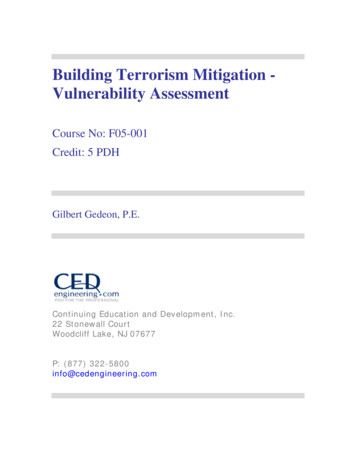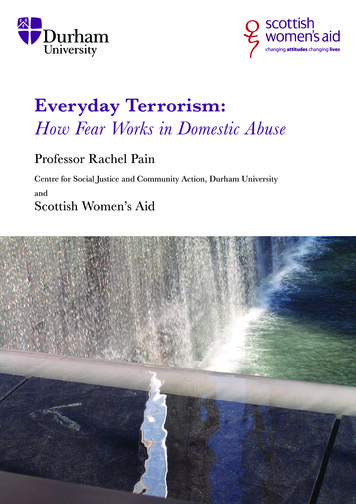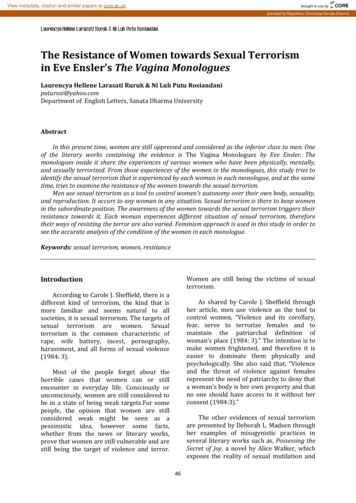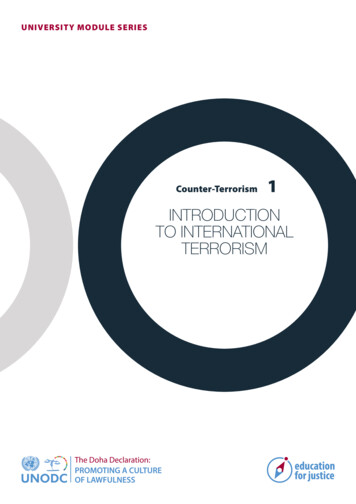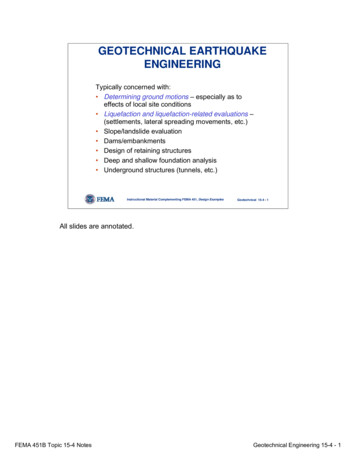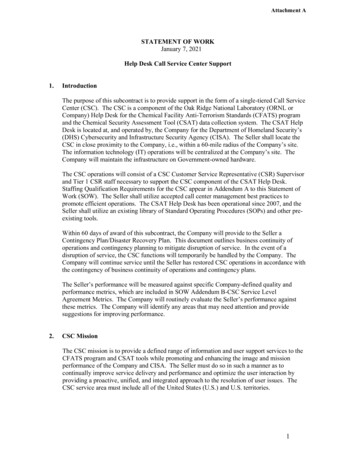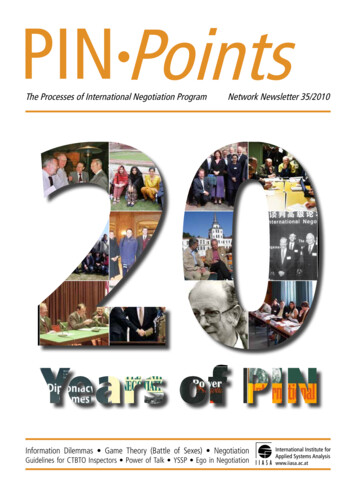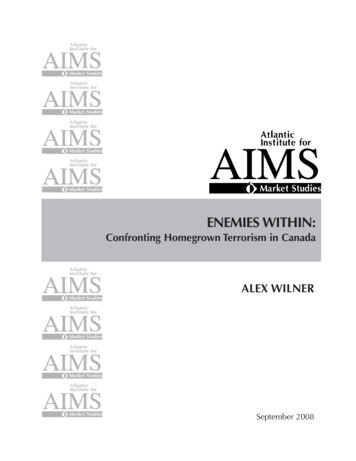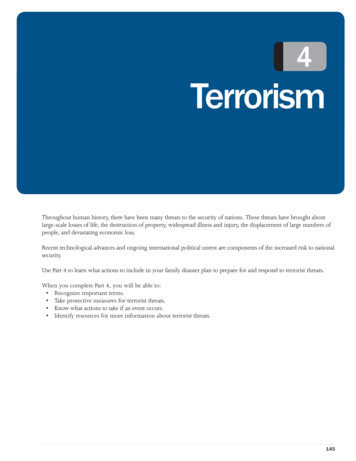
Transcription
4TerrorismThroughout human history, there have been many threats to the security of nations. These threats have brought aboutlarge-scale losses of life, the destruction of property, widespread illness and injury, the displacement of large numbers ofpeople, and devastating economic loss.Recent technological advances and ongoing international political unrest are components of the increased risk to nationalsecurity.Use Part 4 to learn what actions to include in your family disaster plan to prepare for and respond to terrorist threats.When you complete Part 4, you will be able to: Recognize important terms. Take protective measures for terrorist threats. Know what actions to take if an event occurs. Identify resources for more information about terrorist threats.145
146
4.1General Informationabout Terrorism
4.1General Info about TerrorismAre You Ready?Terrorism is the use of force or violence against persons or property in violation ofthe criminal laws of the United States for purposes of intimidation, coercion, orransom. Terrorists often use threats to: Create fear among the public. Try to convince citizens that their government is powerless to preventterrorism. Get immediate publicity for their causes.Acts of terrorism include threats of terrorism; assassinations; kidnappings; hijackings; bomb scares and bombings; cyber attacks (computer-based); and the use ofchemical, biological, nuclear and radiological weapons.High-risk targets for acts of terrorism include military and civilian governmentfacilities, international airports, large cities, and high-profile landmarks. Terrorists might also target large public gatherings, water and food supplies, utilities,and corporate centers. Further, terrorists are capable of spreading fear by sendingexplosives or chemical and biological agents through the mail.Within the immediate area of a terrorist event, you would need to rely on police,fire, and other officials for instructions. However, you can prepare in much thesame way you would prepare for other crisis events.The following are general guidelines: Be aware of your surroundings. Move or leave if you feel uncomfortable or if something does not seem right. Take precautions when traveling. Be aware of conspicuous or unusual behavior. Do not accept packages from strangers. Do not leave luggage unattended.You should promptly report unusual behavior, suspicious or unattended packages, and strange devices to the police or security personnel. Learn where emergency exits are located in buildings you frequent. Plan howto get out in the event of an emergency. Be prepared to do without services you normally depend on—electricity,telephone, natural gas, gasoline pumps, cash registers, ATMs, and Internettransactions.148
Are You Ready?General Info about Terrorism4.1 Work with building owners to ensure the following items are located on eachfloor of the building:- Portable, battery-operated radio and extra batteries.- Several flashlights and extra batteries.- First aid kit and manual.- Hard hats and dust masks.Terrorism- Fluorescent tape to rope off dangerous areas.149
150
4.2Explosions
4.2ExplosionsAre You Ready?Terrorists have frequently used explosive devices as one of their most commonweapons. Terrorists do not have to look far to find out how to make explosive devices; the information is readily available in books and other information sources.The materials needed for an explosive device can be found in many places including variety, hardware, and auto supply stores. Explosive devices are highly portableusing vehicles and humans as a means of transport. They are easily detonated fromremote locations or by suicide bombers.Conventional bombs have been used to damage and destroy financial, political,social, and religious institutions. Attacks have occurred in public places and on citystreets with thousands of people around the world injured and killed.Parcels that should make you suspicious: Are unexpected or from someone unfamiliar to you. Have no return address, or have one that can’t be verified as legitimate. Are marked with restrictive endorsements such as “Personal,” “Confidential,” or “Do not X-ray.” Have protruding wires or aluminum foil, strange odors, or stains. Show a city or state in the postmark that doesn’t match the return address. Are of unusual weight given their size, or are lopsided or oddlyshaped. Are marked with threatening language. Have inappropriate or unusual labeling. Have excessive postage or packaging material, such as masking tapeand string. Have misspellings of common words. Are addressed to someone no longer with your organization or areotherwise outdated. Have incorrect titles or titles without a name. Are not addressed to a specific person. Have hand-written or poorly typed addressess.152
Are You Ready?Explosions4.2Take Protective MeasuresIf you receive a telephoned bomb threat, you should do the following: Get as much information from the caller as possible. Keep the caller on the line and record everything that is said. Notify the police and the building management.If there is an explosion, you should: Get under a sturdy table or desk if things are falling around you. When theystop falling, leave quickly, watching for obviously weakened floors and stairways. As you exit from the building, be especially watchful of falling debris. Leave the building as quickly as possible. Do not stop to retrieve personal possessions or make phone calls. Do not use elevators.During an ExplosionReviewSafety guidelinesfor escaping firesin Section 2.11Once you are out:Terrorism Do not stand in front of windows, glass doors, or other potentially hazardousareas. Move away from sidewalks or streets to be used by emergency officials or others still exiting the building.If you are trapped in debris: If possible, use a flashlight to signal your location to rescuers. Avoid unnecessary movement so you don’t kick up dust. Cover your nose and mouth with anything you have on hand. (Dense-weavecotton material can act as a good filter. Try to breathe through the material.) Tap on a pipe or wall so rescuers can hear where you are. If possible, use a whistle to signal rescuers. Shout only as a last resort. Shouting can cause a person to inhale dangerousamounts of dust.153
4.2After an ExplosionExplosionsAre You Ready?Follow the instructions for recovering from a disaster in Part 5.For More InformationIf you require more information about any of these topics, the followingresource may be helpful.PublicationsAmerican Red Cross:Terrorism, Preparing for the Unexpected. Document providing preparation guidelines fora terrorist attack or similar emergency. Available online at www.redcross.org/services/disaster/0,1082,0 589 ,00.html154
4.3BiologicalThreats
4.3Biological ThreatsAre You Ready?Biological agents are organisms or toxins that can kill or incapacitate people, livestock, and crops. The three basic groups of biological agents that would likely beused as weapons are bacteria, viruses, and toxins. Most biological agents are difficult to grow and maintain. Many break down quickly when exposed to sunlightand other environmental factors, while others, such as anthrax spores, are verylong lived. Biological agents can be dispersed by spraying them into the air, byinfecting animals that carry the disease to humans, and by contaminating food andwater. Delivery methods include: Aerosols—biological agents are dispersed into the air, forming a fine mistthat may drift for miles. Inhaling the agent may cause disease in people oranimals. Animals—some diseases are spread by insects and animals, such as fleas,mice, flies, mosquitoes, and livestock. Food and water contamination—some pathogenic organisms and toxinsmay persist in food and water supplies. Most microbes can be killed, and toxins deactivated, by cooking food and boiling water. Most microbes are killedby boiling water for one minute, but some require longer. Follow officialinstructions. Person-to-person—spread of a few infectious agents is also possible. Humans have been the source of infection for smallpox, plague, and the Lassaviruses.Specific information on biological agents is available at the Centers for DiseaseControl and Prevention’s Web site, www.bt.cdc.gov.Take Protective MeasuresBefore a Biological AttackThe following are guidelines for what you should do to prepare for a biologicalthreat: Check with your doctor to ensure all required or suggested immunizations areup to date. Children and older adults are particularly vulnerable to biologicalagents.156
Are You Ready?Biological Threats4.3 Consider installing a High Efficiency Particulate Air (HEPA) filter in your furnace return duct. These filters remove particles in the 0.3 to 10 micron rangeand will filter out most biological agents that may enter your house. If youdo not have a central heating or cooling system, a stand-alone portable HEPAfilter can be used.ReviewShelterin Section 1.4Filtration in BuildingsBuilding owners and managers should determine the type and level offiltration in their structures and the level of protection it provides againstbiological agents. The National Institute of Occupational Safety andHealth (NIOSH) provides technical guidance on this topic in their publication Guidance for Filtration and Air-Cleaning Systems to Protect Building Environmentsfrom Airborne Chemical, Biological, or Radiological Attacks. To obtain a copy, call1(800)35NIOSH or visit www.cdc.gov/NIOSH/publist.html and requestor download NIOSH Publication 2003-136.During a Biological AttackTerrorismIn the event of a biological attack, public health officials may not immediately beable to provide information on what you should do. It will take time to determine what the illness is, how it should be treated, and who is in danger. Watchtelevision, listen to radio, or check the Internet for official news and informationincluding signs and symptoms of the disease, areas in danger, if medications orvaccinations are being distributed, and where you should seek medical attention ifyou become ill.The first evidence of an attack may be when you notice symptoms of the diseasecaused by exposure to an agent. Be suspicious of any symptoms you notice, butdo not assume that any illness is a result of the attack. Use common sense andpractice good hygiene.If you become aware of an unusual and suspicious substance nearby: Move away quickly. Wash with soap and water. Contact authorities. Listen to the media for official instructions. Seek medical attention if you become sick.If you are exposed to a biological agent: Remove and bag your clothes and personal items. Follow official instructionsfor disposal of contaminated items. Wash yourself with soap and water and put on clean clothes. Seek medical assistance. You may be advised to stay away from others or evenquarantined.157
4.3Biological ThreatsAre You Ready?Using HEPA FiltersHEPA filters are useful in biological attacks. If you have a central heating and cooling system in your home with a HEPA filter, leave it on if itis running or turn the fan on if it is not running. Moving the air in thehouse through the filter will help remove the agents from the air. If youhave a portable HEPA filter, take it with you to the internal room whereyou are seeking shelter and turn it on.If you are in an apartment or office building that has a modern, centralheating and cooling system, the system’s filtration should provide a relatively safe level of protection from outside biological contaminants.HEPA filters will not filter chemical agents.After a Biological AttackReviewGettingInformedin Section 1.1158In some situations, such as the case of the anthrax letters sent in 2001, people maybe alerted to potential exposure. If this is the case, pay close attention to all officialwarnings and instructions on how to proceed. The delivery of medical servicesfor a biological event may be handled differently to respond to increased demand.The basic public health procedures and medical protocols for handling exposure tobiological agents are the same as for any infectious disease. It is important for youto pay attention to official instructions via radio, television, and emergency alertsystems.
4.4ChemicalThreats
4.4Chemical ThreatsAre You Ready?Chemical agents are poisonous vapors, aerosols, liquids, and solids that have toxiceffects on people, animals, or plants. They can be released by bombs or sprayedfrom aircraft, boats, and vehicles. They can be used as a liquid to create a hazard topeople and the environment. Some chemical agents may be odorless and tasteless.They can have an immediate effect (a few seconds to a few minutes) or a delayedeffect (2 to 48 hours). While potentially lethal, chemical agents are difficult to deliver in lethal concentrations. Outdoors, the agents often dissipate rapidly. Chemical agents also are difficult to produce.A chemical attack could come without warning. Signs of a chemical release includepeople having difficulty breathing; experiencing eye irritation; losing coordination;becoming nauseated; or having a burning sensation in the nose, throat, and lungs.Also, the presence of many dead insects or birds may indicate a chemical agentrelease.Take Protective MeasuresBefore a Chemical AttackThe following are guidelines for what you should do to prepare for a chemicalthreat: Check your disaster supplies kit to make sure it includes:- A roll of duct tape and scissors.- Plastic for doors, windows, and vents for the room in which you will shelterin place. To save critical time during an emergency, pre-measure and cut theplastic sheeting for each opening. Choose an internal room to shelter, preferably one without windows and onthe highest level.During a Chemical AttackThe following are guidelines for what you should do in a chemical attack.If you are instructed to remain in your home or office building, you should:ReviewShelter safety forsealed rooms inSection 3.1 Close doors and windows and turn off all ventilation, including furnaces, airconditioners, vents, and fans. Seek shelter in an internal room and take your disaster supplies kit. Seal the room with duct tape and plastic sheeting. Listen to your radio for instructions from authorities.160
Are You Ready?Chemical Threats4.4If you are caught in or near a contaminated area, you should: Move away immediately in a direction upwind of the source. Find shelter as quickly as possible.After a Chemical AttackTerrorismDecontamination is needed within minutes of exposure to minimize health consequences. Do not leave the safety of a shelter to go outdoors to help others untilauthorities announce it is safe to do so.A person affected by a chemical agent requires immediate medical attention from aprofessional. If medical help is not immediately available, decontaminate yourselfand assist in decontaminating others.Decontamination guidelines are as follows: Use extreme caution when helping others who have been exposed to chemical agents. Remove all clothing and other items in contact with the body. Contaminatedclothing normally removed over the head should be cut off to avoid contactwith the eyes, nose, and mouth. Put contaminated clothing and items into aplastic bag and seal it. Decontaminate hands using soap and water. Removeeyeglasses or contact lenses. Put glasses in a pan of household bleach to decontaminate them, and then rinse and dry. Flush eyes with water. Gently wash face and hair with soap and water before thoroughly rinsingwith water. Decontaminate other body areas likely to have been contaminated. Blot (donot swab or scrape) with a cloth soaked in soapy water and rinse with clearwater. Change into uncontaminated clothes. Clothing stored in drawers or closets islikely to be uncontaminated. Proceed to a medical facility for screening and professional treatment.161
162
4.5NuclearBlast
4.5Nuclear BlastAre You Ready?A nuclear blast is an explosion with intense light and heat, a damaging pressurewave, and widespread radioactive material that can contaminate the air, water, andground surfaces for miles around. A nuclear device can range from a weapon carried by an intercontinental missile launched by a hostile nation or terrorist organization, to a small portable nuclear devise transported by an individual. All nucleardevices cause deadly effects when exploded, including blinding light, intense heat(thermal radiation), initial nuclear radiation, blast, fires started by the heat pulse,and secondary fires caused by the destruction.Hazards of Nuclear DevicesThe extent, nature, and arrival time of these hazards are difficult to predict. Thegeographical dispersion of hazard effects will be defined by the following: Size of the device. A more powerful bomb will produce more distant effects. Height above the ground the device was detonated. This will determine theextent of blast effects. Nature of the surface beneath the explosion. Some materials are more likelyto become radioactive and airborne than others. Flat areas are more susceptible to blast effects. Existing meteorological conditions. Wind speed and direction will affect arrival time of fallout; precipitation may wash fallout from the atmosphere.Radioactive FalloutEven if individuals are not close enough to the nuclear blast to be affected bythe direct impacts, they may be affected by radioactive fallout. Any nuclear blastresults in some fallout. Blasts that occur near the earth’s surface create muchgreater amounts of fallout than blasts that occur at higher altitudes. This is because the tremendous heat produced from a nuclear blast causes an up-draft ofair that forms the familiar mushroom cloud. When a blast occurs near the earth’ssurface, millions of vaporized dirt particles also are drawn into the cloud. Asthe heat diminishes, radioactive materials that have vaporized condense on theparticles and fall back to Earth. The phenomenon is called radioactive fallout.This fallout material decays over a long period of time, and is the main source ofresidual nuclear radiation.Fallout from a nuclear explosion may be carried by wind currents for hundredsof miles if the right conditions exist. Effects from even a small portable deviceexploded at ground level can be potentially deadly.Nuclear radiation cannot be seen, smelled, or otherwise detected by normalsenses. Radiation can only be detected by radiation monitoring devices. Thismakes radiological emergencies different from other types of emergencies, suchas floods or hurricanes. Monitoring can project the fallout arrival times, whichwill be announced through official warning channels. However, any increase insurface build-up of gritty dust and dirt should be a warning for taking protectivemeasures.164
Are You Ready?Nuclear Blast4.5Electromagnetic PulseTerrorismIn addition to other effects, a nuclear weapon detonated in or above the earth’satmosphere can create an electromagnetic pulse (EMP), a high-density electricalfield. An EMP acts like a stroke of lightning but is stronger, faster, and shorter.An EMP can seriously damage electronic devices connected to power sources orantennas. This includes communication systems, computers, electrical appliances, and automobile or aircraft ignition systems. The damage could rangefrom a minor interruption to actual burnout of components. Most electronicequipment within 1,000 miles of a high-altitude nuclear detonation could beaffected. Battery-powered radios with short antennas generally would not beaffected. Although an EMP is unlikely to harm most people, it could harm thosewith pacemakers or other implanted electronic devices.Protection from a Nuclear BlastThe danger of a massive strategic nuclear attack on the United States is predictedby experts to be less likely today. However, terrorism, by nature, is unpredictable.If there were threat of an attack, people living near potential targets could beadvised to evacuate or they could decide on their own to evacuate to an area notconsidered a likely target. Protection from radioactive fallout would require taking shelter in an underground area or in the middle of a large building.In general, potential targets include: Strategic missile sites and military bases. Centers of government such as Washington, DC, and state capitals. Important transportation and communication centers. Manufacturing, industrial, technology, and financial centers. Petroleum refineries, electrical power plants, and chemical plants. Major ports and airfields.165
4.5Nuclear BlastAre You Ready?The three factors for protecting oneself from radiation and fallout are distance,shielding, and time. Distance — the more distance between you and the fallout particles, the better. An underground area such as a home or office building basement offersmore protection than the first floor of a building. A floor near the middle ofa high-rise may be better, depending on what is nearby at that level on whichsignificant fallout particles would collect. Flat roofs collect fallout particles sothe top floor is not a good choice, nor is a floor adjacent to a neighboring flatroof. Shielding — the heavier and denser the materials—thick walls, concrete,bricks, books and earth—between you and the fallout particles, the better. Time — fallout radiation loses its intensity fairly rapidly. In time, you will beable to leave the fallout shelter. Radioactive fallout poses the greatest threat topeople during the first two weeks, by which time it has declined to about 1percent of its initial radiation level.Remember that any protection, however temporary, is better than none at all, andthe more shielding, distance, and time you can take advantage of, the better.Take Protective MeasuresBefore a Nuclear BlastReviewUpdate yoursupplies;see Section 1.2To prepare for a nuclear blast, you should do the following: Find out from officials if any public buildings in your community have beendesignated as fallout shelters. If none have been designated, make your ownlist of potential shelters near your home, workplace, and school. These placeswould include basements or the windowless center area of middle floors inhigh-rise buildings, as well as subways and tunnels. If you live in an apartment building or high-rise, talk to the manager aboutthe safest place in the building for sheltering and about providing for buildingoccupants until it is safe to go out. During periods of increased threat increase your disaster supplies to be adequate for up to two weeks.166
Are You Ready?Nuclear Blast4.5Taking shelter during a nuclear blast is absolutely necessary. Thereare two kinds of shelters—blast and fallout. The following describesthe two kinds of shelters: Blast shelters are specifically constructed to offer some protection against blast pressure, initial radiation, heat, and fire. Buteven a blast shelter cannot withstand a direct hit from a nuclearexplosion. Fallout shelters do not need to be specially constructed forprotecting against fallout. They can be any protected space,provided that the walls and roof are thick and dense enough toabsorb the radiation given off by fallout particles.The following are guidelines for what to do in the event of a nuclear explosion.ReviewShelterrequirements inSection 1.4During a Nuclear BlastIf an attack warning is issued: Take cover as quickly as you can, below ground if possible, and stay thereuntil instructed to do otherwise.Terrorism Listen for official information and follow instructions.If you are caught outside and unable to get inside immediately: Do not look at the flash or fireball—it can blind you. Take cover behind anything that might offer protection. Lie flat on the ground and cover your head. If the explosion is some distanceaway, it could take 30 seconds or more for the blast wave to hit. Take shelter as soon as you can, even if you are many miles from ground zerowhere the attack occurred—radioactive fallout can be carried by the winds forhundreds of miles. Remember the three protective factors: Distance, shielding, and time.Decay rates of the radioactive fallout are the same for any size nuclear device.However, the amount of fallout will vary based on the size of the device and itsproximity to the ground. Therefore, it might be necessary for those in the areaswith highest radiation levels to shelter for up to a month.The heaviest fallout would be limited to the area at or downwind from the explosion, and 80 percent of the fallout would occur during the first 24 hours.After a Nuclear BlastReviewShelterrequirements inSection 1.4People in most of the areas that would be affected could be allowed to come out ofshelter within a few days and, if necessary, evacuate to unaffected areas.167
4.5Nuclear BlastAre You Ready?Returning to Your HomeRemember the following: Keep listening to the radio and television for news about what to do, where togo, and places to avoid. Stay away from damaged areas. Stay away from areas marked “radiationhazard” or “HAZMAT.” Remember that radiation cannot be seen, smelled, orotherwise detected by human senses.Follow the instructions for returning home in Part 5.168
4.6Radiological DispersionDevice (RDD)
4.6Radiological Dispersion Devices (RDD)Are You Ready?Terrorist use of an RDD—often called “dirty nuke” or “dirty bomb”—is considered far more likely than use of a nuclear explosive device. An RDD combines aconventional explosive device—such as a bomb—with radioactive material. It isdesigned to scatter dangerous and sub-lethal amounts of radioactive material over ageneral area. Such RDDs appeal to terrorists because they require limited technicalknowledge to build and deploy compared to a nuclear device. Also, the radioactivematerials in RDDs are widely used in medicine, agriculture, industry, and research,and are easier to obtain than weapons grade uranium or plutonium.The primary purpose of terrorist use of an RDD is to cause psychological fear andeconomic disruption. Some devices could cause fatalities from exposure to radioactive materials. Depending on the speed at which the area of the RDD detonationwas evacuated or how successful people were at sheltering-in-place, the numberof deaths and injuries from an RDD might not be substantially greater than from aconventional bomb explosion.The size of the affected area and the level of destruction caused by an RDD woulddepend on the sophistication and size of the conventional bomb, the type of radioactive material used, the quality and quantity of the radioactive material, andthe local meteorological conditions—primarily wind and precipitation. The areaaffected could be placed off-limits to the public for several months during cleanup efforts.Take Protective MeasuresBefore an RDD EventReviewThere is no way of knowing how much warning time there will be before an attack by terrorists using an RDD, so being prepared in advance and knowing whatto do and when is important. Take the same protective measures you would forfallout resulting from a nuclear blast.Nuclear BlastSection 4.5During an RDD Event170While the explosive blast will be immediately obvious, the presence of radiationwill not be known until trained personnel with specialized equipment are on thescene. Whether you are indoors or outdoors, home or at work, be extra cautious.It would be safer to assume radiological contamination has occurred—particularlyin an urban setting or near other likely terrorist targets—and take the proper precautions. As with any radiation, you want to avoid or limit exposure. This is particularly true of inhaling radioactive dust that results from the explosion. As you seekshelter from any location (indoors or outdoors) and there is visual dust or othercontaminants in the air, breathe though the cloth of your shirt or coat to limit yourexposure. If you manage to avoid breathing radioactive dust, your proximity to theradioactive particles may still result in some radiation exposure.
Are You Ready?Radiological Dispersion Devices (RDD)4.6If the explosion or radiological release occurs inside, get out immediately and seeksafe shelter. Otherwise, if you are:OutdoorsIndoors If you have time, turn off ventilationand heating systems, close windows,vents, fireplace dampers, exhaust fans,and clothes dryer vents. Retrieve yourdisaster supplies kit and a batterypowered radio and take them to yourshelter room.Seek shelter immediately, preferablyunderground or in an interior room ofa building, placing as much distanceand dense shielding as possiblebetween you and the outdoors wherethe radioactive material may be.Seal windows and external doorsthat do not fit snugly with duct tapeto reduce infiltration of radioactiveparticles. Plastic sheeting will notprovide shielding from radioactivitynor from blast effects of a nearbyexplosion.Listen for official instructions andfollow directions.After finding safe shelter, those who may have been exposed to radioactive materialshould decontaminate themselves. To do this, remove and bag your clothing (andisolate the bag away from you and others), and shower thoroughly with soap andwater. Seek medical attention after officials indicate it is safe to leave shelter.Terrorism Seek shelter indoorsimmediately in the nearestundamaged building.If appropriate shelter is notavailable, move as rapidly asis safe upwind and away fromthe location of the explosiveblast. Then, seek appropriateshelter as soon as possible.Listen for official instructionsand follow directions.After an RDD EventContamination from an RDD event could affect a wide area, depending on theamount of conventional explosives used, the quantity and type of radioactive material released, and meteorological conditions. Thus, radiation dissipation rates vary,but radiation from an RDD will likely take longer to dissipate due to a potentiallylarger localized concentration of radioactive material.Follow these additional guidelines after an RDD eve
vices; the information is readily available in books and other information sources. The materials needed for an explosive device can be found in many places includ-ing variety, hardware, and auto supply stores. Explosive devices are highly portable using vehicles and human
